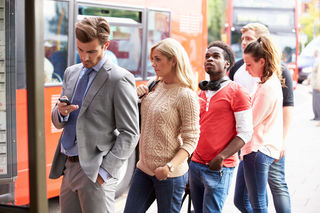Consumer Behavior
New Research on How Waiting Impacts Consumer Behavior
Making the wait worthwhile
Posted August 11, 2017

We spend a lot of time waiting in lines, incurring economic costs due to lost time, as well as psychological costs such as boredom, frustration, and anxiety. Naturally, lines are also costly for companies, as they potentially result in lost sales and lower customer satisfaction.
Given that lines are bad for both consumers and brands, why are they so prevalent? In part, it's because a large line of customers waiting out front is a universal signal of quality. When you walk by a restaurant with no one in it, are you as likely to go in, especially if you have never been there before? Most people would say no.
Beyond denoting quality, there may be another reason for businesses to favor lines, despite their negative consequences. In a recent research project, we examined the effect of waiting in line on customers’ subsequent purchase decisions. We asked whether the fact that one has waited for a long time in line changes their eventual purchase. For instance, imagine that you go to a popular cupcake shop, which is always very busy and always has a long line. After waiting for 45 minutes, you approach the counter to place your order. Or imagine that when you get to a very popular restaurant, you have to wait for an hour before a table opens up. Does the fact that you experienced a long wait influence the number of cupcakes you order or the amount of time you spend in the restaurant?
In a series of experiments conducted in the lab and in the field, we found strong evidence to support the hypothesis that the longer customers wait before making a consumption decision, the more they purchase. For example, diners would want their dinner service to last longer if they had waited longer for a table; shoppers would buy more T-shirts after having a longer wait at a clothing store during sales; and people would play more rounds of an arcade game if they had to wait longer for earlier customers to finish. This is driven by mental accounting: A larger purchase allows people to offset the fixed cost of the long wait. If they were to purchase only a small quantity after investing all that time waiting, the long wait would not seem worthwhile.
This has interesting implications for businesses and consumers. Firms have been trying to improve the customer waiting experience when they are unable to eliminate long waits. (Increasing capacity would obviously help, but it is often not possible due to financial and space constraints.) One feasible strategy is to distract customers’ attention from the unpleasant wait by placing reading materials and TV screens in waiting areas, or playing music. A second practice commonly employed at restaurants and casual eateries is providing customers with a menu to view while they wait. We found that such practices achieve their intended effect of reducing dissatisfaction due to long waits. However they also result in lower actual consumption, suggesting that “higher customer satisfaction” is not always the same as “higher revenue.” This is consistent with the mental accounting perspective: If the time spent waiting is distracted or occupied, it is perceived as a smaller cost. Thus, the sunk-cost effect of waiting is dampened for customers, and their eventual consumption decreases.
Our findings suggest that in certain contexts, a reasonably long wait before customers make a consumption decision can be beneficial for businesses. This is especially the case when the correlation between purchase quantity and service time is low. In such settings, customers adjust the purchase quantity upward in order to justify the amount of time they have waited in line, without displacing the other customers waiting to be served. The positive effect of lines on consumption may not be profitable in situations where the customers increase service time and displace other customers without generating additional revenues for the firm (e.g., fixed-price restaurants).
The magnitude of the decision bias identified in our research may vary across contexts: It can depend on factors such as unit price (consumers who wait in line for the new iPhone will not purchase an additional phone due to a longer wait). There can also be saturation effects; the incremental effect of a long wait may be insignificant for a consumer who already intends to purchase a large quantity due to low price or very high quality.
What does all this mean for consumers waiting in line? Next time you are in a long line, if you do not want to make a large purchase that you might later regret, we suggest that you distract your attention away from the time you spend waiting as much as you can.
John Cui is an assistant professor of operations and information management at Georgetown’s McDonough School of Business, Chris Hydock is an assistant professor and the Research Director of the Georgetown Institute for Consumer Research, and Sezer Ülkü is an associate professor of operations and information management at Georgetown’s McDonough School of Business.


